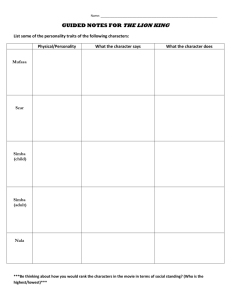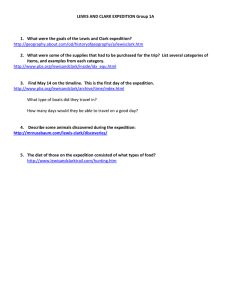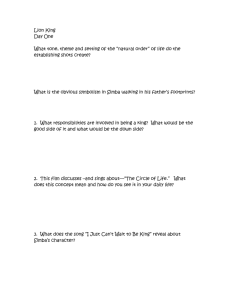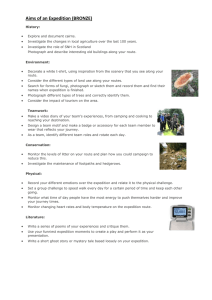– Boerne, TX Fabra Elementary Our Expedition to Antarctica
advertisement
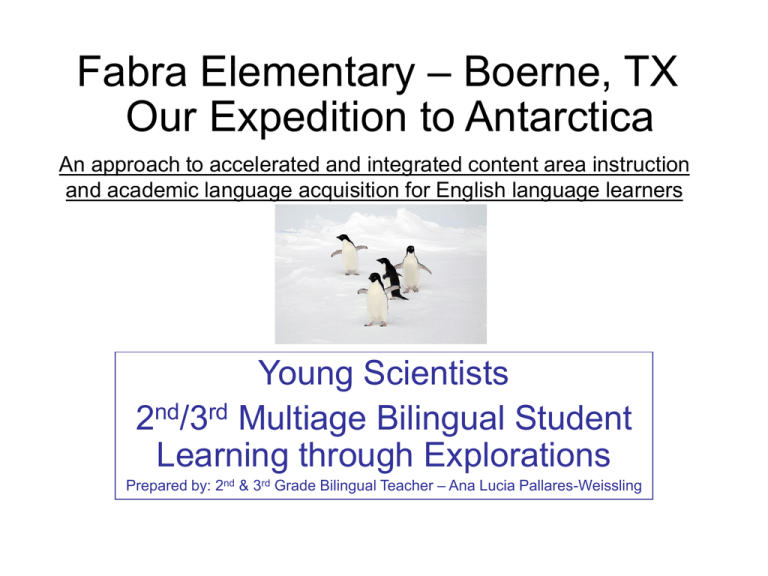
Fabra Elementary – Boerne, TX Our Expedition to Antarctica An approach to accelerated and integrated content area instruction and academic language acquisition for English language learners Young Scientists 2nd/3rd Multiage Bilingual Student Learning through Explorations Prepared by: 2nd & 3rd Grade Bilingual Teacher – Ana Lucia Pallares-Weissling Content • • • • • • • Involvement on Antarctica Studies Students participating in the SIMBA expedition Rationale for Participating in the SIMBA expedition Academic/Classroom Objectives Academic Activities – Samples of diverse classroom activities during the expedition (see pictures) – Sea Ice/Antarctic Model & Ice breaker breaking through the sea-ice demonstration. – Create a tri-dimensional Antarctic Model using diverse materials. – Use of globes and world maps to follow entire expedition and create a time line. – Locate and record data from SIMBA expedition on maps and models using information provided by SIMBA geologist Blake Weissling, and the latitude and longitude concepts. – Collect photos and information to create a class SIMBA expedition and photo album. – Make demonstrations of how to dress appropriately to work on Antarctic weather conditions. Create graphic models using diverse materials and use the descriptive writing format to explain this activity. – Communicate and maintain a collection of emails between students and SIMBA scientists. – Share acquired knowledge to pretend demonstrations of reporters interviewing researchers/scientist. – Demonstrate through experimentation with fans the concepts of wind factor and wind force. – Maintain communication during the expedition with Geologist Mr. Weissling and other sources. – Use books and technology about Antarctica, Sea Ice and Sea Ice Mass to acquire more information. Extensions – Invite 6th grade students to have a live phone conference with Geologist Mr. Weissling and give a presentation to 2nd grade students about the concepts of latitude and longitude. – Share the knowledge with the school and community – Set an exhibit in the school with information, models and pictures to be viewed by the school student population, personnel, parents and visitors (see picture) . Academic Activities for the reminder of the 07-08 school year – Continue studies according to the grade level expectations in the areas of physical and earth sciences. – Learning more about the different professionals who were involved to provide all the resources, needs and research required for an expedition like SIMBA 2007. – Follow up on expedition data collection and results to apply math concepts and create graphs and charts. – During the reminder 6 months of the school year, continue the writing process to have each student complete, edit and illustrate a final publication about all the knowledge and experiences acquired from “their” SIMBA Expedition to the Sea Ice in Antarctica. – Create a dramatization about real facts of the SIMBA expedition to present to other students and parents. Involvement on Antarctic Studies • Every January the 1st grade and primary multiage bilingual students participates in the studies of an Antarctic Unit. This yearly study was initiated about 8 years ago by Mrs. Cheryl Schmidt, a veteran Boerne ISD teacher, who has fosters the value and importance of exposing young learners to the knowledge and understanding of such an important and fascinating theme of study. Along with the activities and studies, students create an exhibit with models of penguins made of diverse materials. • January 2007. Professor Steven Ackley and Mrs. Cicek visit to Fabra Elementary in Boerne, Texas. Fabra’s 1st, 2nd & bilingual students (approximately 230 students, teachers & administrators) were excited by the visit and presentation of Professor Ackley and Mrs. Cicek about the 2006 Antarctic Expedition. Our students and teachers felt very fortunate to receive very important information about the Sea Ice and the expedition directly from expert scientist Professor Ackley and his Doctorate student. Our class and school became more motivated about the knowledge of Antarctica, the Sea Ice and the impact of these aspects in the future of our planet. • Invitation to participate in the SIMBA Expedition. Professor Steve Ackley from the University of Texas in San Antonio extended through Fabra Elementary an invitation to have a teacher from Boerne Independent School District participate in the 2007 expedition to Antarctica. A Middle or High school teacher was considered due the importance for immediate exposure to scientific areas of study to upcoming high school graduate students. However, the 2nd/3rd bilingual class highly considered the opportunity to participate and follow the expedition and integrate the information acquired into the daily academic curriculum (through technology and satellite communication). Students Participating in the SIMBA Expedition We are 2nd and 3rd grade bilingual students and our classroom is always “freezing” like at 50º F degrees. It is not too hard to feel like we are in Antarctica. From September 27, which was our first day of school, to October 31, we have been enjoying starting every school day looking at pictures directly from Antarctica. While the SIMBA expedition was in Antarctica, we felt like we were the scientists too, holding meetings and making experiments. We have a scientific journal and we have been writing about all the information about Antarctica, the Ice breaker Nathaniel B. Palmer, the scientist and researchers and their experiments, Palmer Station, Penguins, Punta Arenas and Chile. Rationale for Participating in the SIMBA Expedition 1. As an educator and individual, I consider that there is an immediate need to better expose and educate students from early years in the areas of science in order to help them understand the importance of learning, caring and preserving their planet. Every student, but particularly students considered at risk due limitation in language, experiences and opportunities are in ever more need to learn about this area of study. 2. Boerne ISD and the national education system in general are concerned about the need to better prepare students from K-12th in the areas of understanding and knowledge of science. There is a great national need for higher academic achievement and performance in the academic scientific areas in the grades 3rd - 12th,; particularly for those students considered limited English speakers or minorities; as well as high school graduates interested in college or technical degrees in the different areas of science. 3. Research in education has demonstrated that learning is better acquired when students are exposed to factual, meaningful, and hands on experiences. Young learners have a natural tendency to learn exploring their world and surroundings. Formal education must foster this natural tendency by providing continued opportunities for learning through exploration during all elementary and secondary years. Reading, writing and mathematical knowledge, concepts and practice can be highly integrated through scientific academic activities. 4. Contemporary education calls for individual who are developing as critical and active thinkers. This ability, particularly in young learners, can be acquired when students are provided the opportunity to be motivated and be active participants in the process of learning. Real experiences are great motivators for learning at any level of education. 5. In addition to the aspects indicated above, English Language Learners ELL (bilingual &/or minority students) have a greater need to be introduced and expose to the language and knowledge of science at an early years. Scientific knowledge through exploration provides a realistic exposure to understanding common process. Also, scientific terminology has a common foundation and structure which provides a base for English language acquisition and development. The scientific academic experiences at school provide these young learners with concrete elements to acquire academic knowledge while they become fluent English speakers, readers and writers. These students (ELL) are expected to formally perform academically and linguistically in English in order to obtain a High School degree. Academic/Classroom Objectives • • • • • Foster in young students the knowledge, understanding, appreciation, care and need to preserve their planet and it’s natural resources. Provide bilingual (and at risk) students with real life experiences that motivate them to learn, allows them to become inquisitive learners, and help them to become part of the process of acquiring and using a variety of factual scientific, mathematical and other academic knowledge and information. Provide bilingual young students with educational academic and linguistic opportunities that will help them to develop high order thinking skills and an understanding of the learning and scientific processes. These skills will help the students to become academically successful and acquire the levels of achievement equivalent to the rest of the students population in the nation. Additionally in the linguistic area, give young bilingual learners the opportunity to become familiar, acquire and use academic concepts and vocabulary (in Spanish and English) necessary in formal education. Provide bilingual (and at risk) students with meaningful relationships (with people and places) and experiences that introduce them to understand that there are extensive areas of professional opportunities in their future. Participating and Following the SIMBA expedition Academic Activities Classroom Experiments How the Sea Ice forms? & How an Ice breaker moves through the Sea Ice? ? Antarctica is a continent. How a continent is formed? and how a volcano is formed? Participating and Following the SIMBA expedition Academic Activities Mapping skills -Locate SIMBA expedition and record data on journal and tridimensional model. Discovering and understanding the wind factor and wind force. Participating and Following the SIMBA expedition • Note taking – Scientific Journal Writing – Scientific Process • Meeting of the Little Scientists Group - scientific discussions Comparing and understanding scientific concepts using two Sea Ice Models Participating and Following the SIMBA expedition • Phone Meetings with Geologist Mr. Blake P.Weissling • Knowledge exchange with 6th Grade Students – Learning about latitude and longitude and how locate and follow the SIMBA expedition location. Participating and Following the SIMBA expedition • Extended Scientific Activities Create models of ice breaker, Palmer Station, emergency boats, icebergs and Antarctic islands, penguins, scientific equipment, igloo. The Sea Ice forms around Antarctica every winter School Exhibit Setting the exhibit based on information researched and reported Jan. /07 After Professor Ackley and Mrs. Cicek first studies and presentation about the Sea Ice and Antarctica wild life. Participating and Following the SIMBA expedition Fabra Elementary + Antarctica = FABRANTARCTICA Dressing up like an Antarctic researcher & Reporting live from Fabra-Antarctica. Using acquired knowledge to give information during a “pretend” interview. THE SIMBA TEAM IS BACK Very Special Event Visit from scientists and explores Professor Ackley, Mrs. Cicek and Miss. Wagner visit to our classroom. A scientific collaboration. New generation learning from the experts. Looking at the Sea Ice & Antarctica Exhibit Students listen attentively, share knowledge and ask questions during the scientist visit Boerne ISD Superintendent Dr. John P. Kelly with Professor Steve Ackley Participating and Following the SIMBA expedition Some other scientific activities (pictures no included): ● Studying, researching and creating pictures of scientific instruments used by the scientists during their SIMBA expedition. ● Creating graphs with information acquired through explorations and observations. ● “There are minerals on the different layers of the land like copper (CO)”. Research and polish a Chilean copper coin using lemon, ketchup, baking soda & tooth paste. The Future SIMBA Generation Science is an Universal Language We are the young explores from the present and the committed scientist of the future! Thank you for sharing the knowledge, we will see you soon! Good By!!!! SIMBA expedition Thank you to The National Science Foundation, The University of Texas in San Antonio, Professor Steven Ackley and his Research Team, geologist Blake Weissling also from Professor Ackley’s team for keeping us fully informed, all the SIMBA scientist support group, Mrs. Anderson for her journal, Nathaniel B. Palmer Capitan Michael Watson and his crew members for keeping every one safe, and to all for making us part of this Valuable and Unique Expedition to Antarctica.

